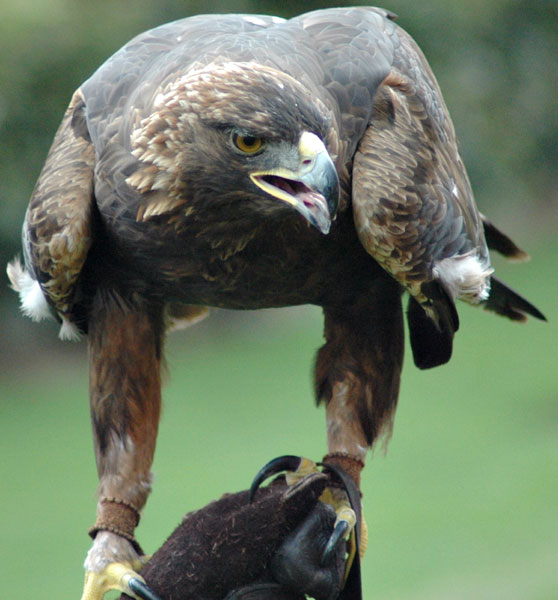| Kingdom: Animalia Phylum: Chordata Class: Aves (Birds) Order: Falconiformes Family: Accipitridae |
Golden Eagle (Aquila chrysaetos) is a local resident in India. Golden Eagles are large, dark and majestic birds with long wings. Fairly common in the hilly or mountainous terrain, Golden Eagles hunt over open expanses of tundra. The name "eagle" is derived from the Latin word, "aquila". The Latin name, Aquila chrysaetos, means "golden-colored eagle of the upper air" and refers to the yellow to golden-brown wash over the nape. Golden Eagle populations barely stable and are subject to decline from electrocution on power lines and poisoning intended for other animals. Size: 78-88 cm. Identification: These large raptors display the golden nape of their namesake in all plumages. Adult plumage is acquired in 4 years and is dark brown overall, although the tail is faintly banded. Juveniles seen in flight from below show well-defined, white patches at the base of their primary wing feathers and conspicuous white tails with a dark terminal band. Appearing "broad-handed" at a distance, Golden Eagles often soar with their long, large wings slightly uplifted at the tips. In flight, their wing beats are relatively smooth and shallow Calls: The Golden Eagle gives a rather weak, high yelp. Adults make a two-syllable "kee-yep" sound in a slow, measured series. When begging, juveniles call with piercing, insistent "ssseeeeeeee-chk" or "kikikikikikikikikiki-yelp" notes. Nests: Golden Eagles nest in high, defensible positions with broad views on cliffs, ledges or trees. Both parents construct the bulky nest of interwoven sticks, brush and leaves and softly line it with fine materials. Often, 2-3 nests are occupied alternately during one breeding season. Nests that are used and refurbished each year become very large. Aromatic leaves are added regularly to the nest lining to protect the 1-4, 75 mm eggs of the clutch from insects and pests. The eggs are white to creamy buff and are marked in browns, though 1 egg is usually unmarked. A long-term pair bond forms between the parents. Both parents hunt during incubation and chick-rearing, but the male is the primary hunter. Although the male rarely feeds the young directly, he feeds the female when she is on the nest. While the female does the majority of the 43-45 day incubation, the male assists her for a short period during the day. Young birds fledge in 66-75 days post-hatching and are reared by both parents. Food: Golden Eagles primarily prey upon small mammals such as hares, birds, insects and carrion. When hunting, they swoop over open country in search of food and take prey in spectacular stoops (dives from high altitudes). Hunting solo or in pairs, these large raptors are capable of preying on lambs and small goats. |
| |

